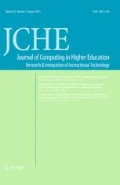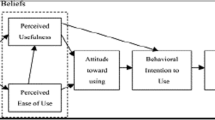Abstract
This study focused on perceived technology knowledge and acceptance of Iranian university students. Survey data were collected from 215 freshmen students of 12 majors from a state university of technology in Tehran, Iran. The survey was comprised of 29 items arranged into two scales, namely technology knowledge and technology acceptance (with three sub-scales: perceived technology self-efficacy, ease of use, and usefulness) as the dependent variables. Descriptive and MANOVA analyses were conducted to explore participants’ perception towards these factors, the possible impact of gender, computer ownership, and major of study as independent variables on technology knowledge and acceptance, and the correlation between the dependent variables. The majority of participants perceived themselves as novice or slightly-better-than-novice users of technology. While the results yielded a generally positive technology self-efficacy, the respondents appeared largely uncertain about usefulness and ease of use of technology. The findings supported that male participants demonstrated more self-efficacy towards technology compared to the females. A statistically significant difference was found in technology knowledge of respondents majoring at computer engineering with the rest of the participants. Further, students with a personal computer demonstrated higher levels of technology knowledge and perceived technology easy to use. Pearson product moment correlation coefficients indicated that technology knowledge positively correlated with the three constructs of technology acceptance. Addressing students’ technology proficiency and acceptance is a critical step for designing and/or redefining technology-enhanced courses and programs.
Similar content being viewed by others
References
Bandura, A. (1997). Self-efficacy: The exercise of control. New York: Freeman.
Bates, R., & Khasawneh, S. (2007). Self-efficacy and college students’ perceptions and use of online learning systems. Computers in Human Behavior, 23(1), 175–191.
Comprehensive National Scientific Plan. (2016). Supreme Council of Cultural Revolution. Retrieved from https://isacmsrt.ir/files/site1/pages/naghshe_jame_elmi.pdf
Davis, F. D. (1989). Perceived usefulness, perceived ease of use, and user acceptance of information technology. MIS Quarterly, 13(3), 319–340.
Davis, F. D., Bagozzi, R. P., & Warshaw, P. R. (1992). Extrinsic and intrinsic motivation to use computers in the workplace. Journal of Applied Social Psychology, 22(14), 1111–1132.
Donovan, J., Green, T., & Hansen, L. E. (2011). One-to-one laptop teacher education: Does involvement affect candidate technology skills and dispositions? Journal of Research on Technology in Education, 44, 121–139.
Edmunds, R., Thorpe, M., & Conole, G. (2012). Student attitudes toward and use of ICT in course study, work and social activity: A technology acceptance model approach. British Journal of Educational Technology, 43(1), 71–84.
Fletcher, K. M. (2005). Self-efficacy as an evaluation measure for programs in support of online learning literacies for undergraduates. Internet and Higher Education, 8(4), 307.
Hatlevik, O. E., Guðmundsdottir, G. B., & Loi, M. (2015). Digital diversity among upper secondary students: A multilevel analysis of the relationship between cultural capital, self efficacy, strategic use of information and digital competence. Computers & Education, 81, 345–353.
Hinton, P. R., Brownlow, C., McMurray, I., & Cozens, B. (2004). SPSS explained. New York: Routledge Taylor & Francis Group.
Internet World Stats Usage and Population Statistics. (2017). Iran Internet usage, broadband and telecommunication reports. Retrieved from http://www.internetworldstats.com/me/ir.htm
Joo, Y. J., Lim, K. Y., & Kim, J. (2013). Locus of control, self-efficacy, and task value as predictors of learning outcome in an online university context. Computers & Education, 62, 149–158.
Kao, C. P., & Tsai, C. C. (2009). Teachers’ attitudes toward web-based professional development, with relation to Internet self-efficacy and beliefs about web-based learning. Computers & Education, 53, 66–73.
Kim, H. J., & Jang, H. Y. (2015). Factors influencing students’ beliefs about the future in the context of tablet-based interactive classrooms. Computers & Education, 89, 1–15.
Lee, D. Y., & Lehto, M. R. (2013). User acceptance of YouTube for procedural learning: An extension of the Technology Acceptance Model. Computers & Education, 61, 193–208.
Liaw, S. S., & Huang, H. M. (2013). Perceived satisfaction, perceived usefulness and interactive learning environments as predictors to self-regulation in e-learning environments. Computers & Education, 60, 14–24.
Lowerison, G., Sclater, J., Schmid, R. F., & Abrami, P. C. (2006). Student perceived effectiveness of computer technology use in post-secondary classrooms. Computers & Education, 47, 465–489.
McCoy, C. (2010). Perceived self-efficacy and technology proficiency in undergraduate college students. Computers & Education, 55, 1614–1617.
Pamuk, S., & Peker, D. (2009). Turkish pre-service science and mathematics teachers’ computer related self-efficacies, attitudes, and the relationship between these variables. Computers & Education, 53, 454–461.
Papastergiou, M. (2010). Enhancing physical education and sport science students’ self-efficacy and attitudes regarding Information and Communication Technologies through a computer literacy course. Computers & Education, 54, 298–308.
Peng, H., Tsai, C. C., & Wu, Y. T. (2006). University students’ self-efficacy and their attitudes toward the Internet: The role of students’ perceptions of the Internet. Educational Studies, 32(1), 73–86.
Roblyer, M. D. (2003). Integrating educational technology into teaching (3rd ed.). Upper Saddle River, NJ: Merrill Prentice Hall.
Roca, J. C., Chiu, C. M., & Martinez, F. J. (2006). Understanding e-learning continuance intention: An extension of the Technology Acceptance Model. International Journal of Human-Computer Studies, 64, 683–696.
Shaikhi Fini, A. A. (2008). Survey on professors and student’s attitude about virtual learning in Iran universities. WSEAS Transactions on Advances in Engineering Education, 5(4), 252–257.
Shashaani, L., & Khalili, A. (2001). Gender and computers: Similarities and differences in Iranian college students’ attitudes toward computers. Computers & Education, 37, 363–375.
Sun, J. C. Y., & Rueda, R. (2012). Situational interest, computer self-efficacy and self-regulation: Their impact on student engagement in distance education. British Journal of Educational Technology, 43(2), 191–204.
Tarhini, A., Hone, K., & Liu, X. (2015). A cross-cultural examination of the impact of social, organizational and individual factors on educational technology acceptance between British and Lebanese university students. British Journal of Educational Technology, 46(4), 739–755.
Teo, T. (2009). Modeling technology acceptance in education: A study of pre-service teachers. Computers & Education, 52, 302–312.
Teo, T., Milutinovic, V., & Zhou, M. (2016). Modeling Serbian pre-service teachers’ attitudes towards computer use: A SEM and MIMIC approach. Computers & Education, 94, 77–88.
Wang, Y. S., Wu, M. C., & Wang, H. Y. (2009). Investigating the determinants and age and gender differences in the acceptance of mobile learning. British Journal of Educational Technology, 40(1), 92–118.
Warschauer, M. (2002). A developmental perspective on technology in language education. TESOL Quarterly, 36, 453–475.
Warschauer, M. (2008). Whither the digital divide? In D. L. Kleinman, K. A. Cloud-Hansen, C. Matta, & J. Handesman (Eds.), Controversies in science and technology: From chromosomes to cosmos (pp. 140–151). New Rochelle, NY: Liebert.
Wiebe, G., & Kabata, K. (2010). Students’ and instructors’ attitudes toward the use of CALL in foreign language teaching and learning. Computer Assisted Language Learning, 23(3), 221–234.
Wojciechowski, R., & Cellary, W. (2013). Evaluation of learners’ attitude toward learning in ARIES augmented reality environments. Computers & Education, 68, 570–585.
Yaghoubi, J., Malek Mohammadi, I., Iravani, H., Attaran, M., & Gheidi, A. (2008). Virtual students’ perceptions of e-learning in Iran. The Turkish Online Journal of Educational Technology, 7(3), 89–95.
Zamani, B. E., & Gholizadeh Shoghlabad, R. (2010). Acceptance of the Internet by Iranian business management students. British Journal of Educational Technology, 41(5), E96–E100.
Author information
Authors and Affiliations
Corresponding author
Ethics declarations
Conflict of interest
The authors declare that they have no conflict of interest.
Rights and permissions
About this article
Cite this article
Nami, F., Vaezi, S. How ready are our students for technology-enhanced learning? Students at a university of technology respond. J Comput High Educ 30, 510–529 (2018). https://doi.org/10.1007/s12528-018-9181-5
Published:
Issue Date:
DOI: https://doi.org/10.1007/s12528-018-9181-5




